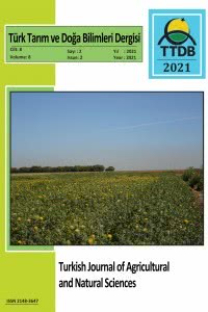Integrated Approach for the Management of New Threat Stemphylium botryosum walr Causing Blight of Lentil (Lens culinaris Medik)
-
Integrated Approach for the Management of New Threat Stemphylium botryosum walr Causing Blight of Lentil (Lens culinaris Medik)
Lentil, Stemphylium botryosum, botanicals, fungicides, antagonist resistant genotypes,
___
- Bakr, M.A., 1991. Plant protection of lentil in Bangladesh. In: Proceedings of the seminar on lentil in South Asia, 11-15 March, 1991. New Delhi, India.
- Bayaa, B., Joshi, S., Karki, P.B., Jha, P., 1998. Lentil disease survey report. 23rd February, 1998, Kathmandu, Nepal
- Bayaa, B., Erskine, W., 1998. Lentil Pathology. Pages 423-472, in: Pathology of Food and Pasture Legumes (eds D. Allen and J. Lenné), Commonwealth International, U.K in association with: International Crop Research Center for the Semi-Arid Tropics, Patancheru 502 324. Andhra Pradesh, India. Bureaux
- Benitez, T., Rincon, A.M., Limon, M.C., Codon, A.C., 2004. Trichoderma Microbiology, 7: 249-260. of strains. International
- Cal, A., Larena, I., Sabuquillo, P., Melgarejo, P., 2004. Biological control of tomato wilts. Recent Research Developments in Crop Science, 1: 97-115.
- Deena, M.J., Thoppil, J.E., 2000. Antimicrobial activity of the essential oil of L. camara. Fitoter 71: 453-5
- Erskine, W., Sarker, A., 1997. Lentil: the Bangladesh breakthrough. ICARDA Carvan No. 6
- Gharti, D.B., Jha, P., Darai, R., Ghale, D., Joshi, S., Wagle, B.P., 2008. Studies on Management of sarciniforme) of Lentil (Lens culinaris L.) at NGLRP, Rampur and RARS, Nepalgunj. In: Program and Abstract of a 27th National Winter Crops Workshop “Ensuring Food Security through Crop Diversification”. Nepal Agricultural Research Council. Pp 35- 36. (Stemphylium
- GLRP, 2012. Annual Report 2068/69 (2011/12). Grain legumes Research Program, NARC, Rampur, Chitwan, Nepal.
- Guo, J.H., Qi, H.Y., Guo, Y.H., Ge, H.L., Gong, L.Y., Zhang, L.X., Sun, P.H., 2004. Bio-control of tomato wilt by plant growth promoting rhizobacteria. Biological Control, 29: 66-72.
- Hosen, M.I., Ahmed, A.U., Zaman, J., Ghosh, S., Hossain, Physiological Variation between Isolates of Stemphylium botryosum the Causal of Stemphylium Blight Disease of Lentil (Lens culinaris). World Journal of Agricultural Sciences 5 (1): 94-98. Cultural and
- Hosen, Md. Iqbal., 2011. Cultural, physiological comparision between two isolates of Botrytis cinerea and Stemphylium botryosum. Emir. J. Food Agric. 23(2): 120-129. sensitivity
- Huang, C.J., Wang, T.K., Chung, S.C., Chen, C.Y., 2005. Identification of an chitinase from a potential bio-control agent, Bacillus cereus 28-9. J. Biochem. Mol. Biol. 38: 82-88. antifungal
- Huq, M. Ishanul, Nowsher Ali Khan, A.Z.M., 2007. Efficacy in-vivo of Different Fungicides in Controlling Stemphylium blight of Lentil During 1998-2001. Bangladesh J.Sci. Ind. Res. 42(1): 89-96
- Joshi, S., 2006. Review of important grain legume their diseases Proceedings of a national workshop on Integrated Pest Management (IPM). Plant Protection Society of Nepal. Pp100-116
- McVicar, R., Panchuk, K., Brenzil, S., Hartley, P., Pearse, S.A.F., Vandenberg, A., Banniza, S., Chongo, C., Walley, F., Gan, Y., 2005. Lentil in Saskatchewan. [Online]. Saskatchewan Agriculture Saskatchewan. http://www.agr.gov.sk.ca/docs/crops/pulse s/production_information/lentilsin SK2002.asp. Govt. of
- MOAD, 2013. Statistical information on Nepalese Agriculture Promotion and Statistics Division, Ministry Agri-Business of Agriculture Development, Kathmandu, Nepal.
- Morrall, R.A.A., Mckenzie, D.L., 1974. A note on the inadvertent introduction to North America of Ascochyta rabiei, a destructive pathogen of chickpea. Plant Disease reporter 58:342- 345
- Oplinger, E.S., Hardman, L.L., Kaminski, A.R., Kelling, K.A., Doll, J.D., 1990. Lentil: Alternative Field Crops Manual. University of Extension and University of Minnesota; Center for Alternative Plant & Animal Products and the Minnesota Extension Sevice. /afcm/lentil.html. Cooperative
- http://www.purdue.edu/newcrop
- Phongpaichit, S., Pujenjob, N., Rukachaisirikul, V., Ongsakul, M., 2005. Antimicrobial activities of the crude methanol extract of Acorus calamus Technol., 27(Suppl. 2): 517-523 J. Sci.
- Shivankar, S.K., Wangikar, P.D., 1993. Effect of different fungicides on the control of gray mildew disease of cotton. Indian Phytopath. 46 (3): 230-235.
- Soytong, K., Srinon, W., Ratanacherdchai, K., Kanokmedhakul, S., Kanokmedhakul, K., 2005. Application of antagonistic fungi to control anthracnose disease of grape. J. Agric. Technol., 1: 33-42.
- Weller, D., Raaijmakers, J., Mespadden Gardener, B.B., Thomasone, L.S., 2002. Microbial Population Responsible for Specific Soil Suppressive has to Plant pathogen. Annu. Rev. Phytopathol.,40: 309-348.
- Wheeler, B.E.J., 1969. An Introduction to Plant Diseases. John Wiley and Sons. Ltd. London. pp. 301.
- Zaman, S.M.H., Rahim, K., Howlader, M.,1982. Simple lesson for biometry. Bangladesh Rice Research Institute, Joydebpur, Dhaka. pp. 171
- ISSN: 2148-3647
- Yayın Aralığı: 4
- Başlangıç: 2014
- Yayıncı: Prof. Dr. Mevlüt AKÇURA
The Cotton Breeding in Bulgaria
Ana STOILOVA, Neli VALKOVA, Boryana HADZHIIVANOVA, Minka KOLEVA, Spasimira NEDYALKOVA
The Effects Of Different Treatments On Carob (Ceratonia Siliqua L.) Seed Germination
Effect of Line on the Production Traits of Fine Fleece Rams
Valuable local apple cultivars and forms of genus Malus in the region of Apriltsi
Teodora STOYANOVA, İvan MINEV, Petko MINKOV, Vasil VITKOV
Nikolay NIKOLOV, Vanya TRINGOVSKA
Anatoli ILIEV, Violeta DIMITROVA, Valeriy PEYKOV, Neli PRODANOVA – MARINOVA
Study on Fruit Staining of Citrus in the Eastern Mediterranean Region of Turkey
Serpil NAS, Pakize Gök GÜLER, Turgut GUVELOGLU
